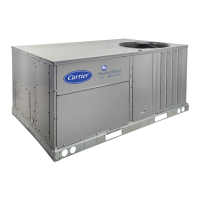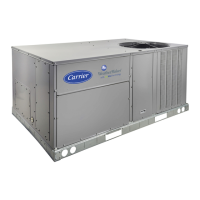ITEM
TIME
HH.MM
DATE
MNTH
DOM
DAY
YEAR
SCH.L
PER. 1
PER. 1-_DA YS
PER. 1-_DA YS-_MON
PER.1 -_DA YS-_ TUE
PER. 1-_DAYS-_WED
PER.1 -_DA YS-_ THU
PER. 1-_DA YS-_FRI
PER. 1-_DA YS-_SA T
PER. 1-_DA YS-_SUN
PER. 1-_DA YS-_HOL
PER. 1-_OCC
PER. 1-_UNC
Repeat for periods 2-8
HOL.L
HD.01
HD.OI-_MON
HD.01 -_DAY
HD.OI-_LEN
Repeat for holidays 2-30
DAES
DS.ST
DS.ST-_ST.MN
DS.ST-_ST. WK
DS.ST-_SEDY
DS.ST-_MIN.A
DS.SP
DS.SP-_SP.MN
DS.SP-_SP. WK
DS.SP-_SP.DY
DS.SP-_MIN.S
Table 93 -- Time Clock Configuration
EXPANSION
TIME OF DAY
Hour and Minute
MONTH,DATE,DAY AND YEAR
Month of Year
Day of Month
Day of Week
Year
LOCAL TIME SCHEDULE
PERIOD 1
DAY FLAGS FOR PERIOD 1
Monday in Period
Tuesday in Period
Wednesday in Period
Thursday in Period
Friday in Period
Saturday in Period
Sunday in Period
Holiday in Period
Occupied from
Occupied to
LOCAL HOLIDAY SCHEDULES
HOLIDAY SCHEDULE 01
Holiday Start Month
Start Day
Duration (Days)
DAYLIGHT SAVINGS TIME
DAYLIGHT SAVINGS START
Month
Week
Day
Minutes to Add
DAYLIGHTS SAVINGS STOP
Month
Week
Day
Minutes to Subtract
RANGE POINT DEFAULT
00:00
multi-text strings
0-31
multi-text strings
e,g, 2003
YES/NO
YES/NO
YES/NO
YES/NO
YES/NO
YES/NO
YES/NO
YES/NO
00:00
00:00
0-12
0-31
0-99
1 -12
1-5
1-7
0 - 90
1 -12
1-5
1-7
0 - 90
TIME
MOY
DOM
DOWDISP
YOCDISP
PER1MON
PER1TUE
PERlWED
PER1THU
PER1FRI
PER1SAT
PER1SUN
PER1HOL
PER10CC
PER1 UNC
HOL_MON1
HOL_DAY1
HOL_LEN1
STARTM
STARTW
STARTD
MINADD
STOPM
STO PW
STOPD
MINSUB
Period 1 only
Yes
Yes
Yes
Yes
Yes
Yes
Yes
Yes
00:00
24:00
4
1
7
6O
10
5
7
6O
TROUBLESHOOTING
The scrolling marquee display shows the actual operating
conditions of the unit while it is running. If there are alarms or
there have been alarms, they will be displayed in either the cur-
rent alarm list or the history alarm list. The Service Testmode
allows proper operation of the compressors, fans, and other
components to be checked while the unit is not operating.
Complete Unit Stoppage -- There are several condi-
tions that can cause the unit not to provide heating or cooling.
If an alarm is active which causes the unit to shut down,
diagnose the problem using the information provided in
the Alarms and Alerts section on page 93, but also check for
the following:
• Cooling and heating loads are satisfied.
• Progralraned schedule.
• General power failure.
• Tripped control circuit transformers circuit breakers.
• Tripped compressor circuit breakers.
• Unit is turned offthrough the CCN network.
Single Circuit Stoppage -- If a single circuit stops
incorrectly, there are several possible causes. The problem
should be investigated using information from the Alarms and
Alerts section on page 93.
Service Analysis- Detailed service analysis can be
found in Tables 94-96 and in Fig. 14.
Restart Procedure -- Before attempting to restart the
machine, check the alarm list to determine the cause of the
shutdown. If the shutdown alarm for a particular circuit has
occurred, determine and correct the cause before allowing the
unit to run under its own control again. When there is problem,
the unit should be diagnosed in Service Test mode. The alarms
must be reset before the circuit can operate in either Normal
mode or Service Test mode.
Thermistor Troubleshooting -- The electronic con-
trol uses five 5K-thermistors for the saturated condensing
temperature on 48/50AJ,AK,AW, AY units (SCT.A and
SCT.B). See Tables 97 and 98 for temperature vs. resistance
data.
When replacing thermistors SCT.A and SCT.B, reuse the
original hardware. These thermistors must be clamped tightly
to the hairpins of the condenser.
The EDT, OAT, RAT, LAT, T55, T56, and T58 space tem-
perature sensors use 10K thermistors. Resistances at various
temperatures are listed in Tables 99 and 100.
THERMISTOR/TEMPERATURE SENSOR CHECK -- A
high quality digital volt-ohiraneter is required to perform this
check.
1. Connect the digital voltmeter across the appropriate ther-
mistor terminals at the J8 terminal strip on the main base
board.
2. Using the voltage reading obtained, read the sensor tem-
perature from Tables 97-100.
3. To check thermistor accuracy, measure temperature at
probe location with an accurate thermocouple-type
temperature-measuring instrument. Insulate thermocou-
ple to avoid ambient temperatures from influencing
reading. Temperature measured by thermocouple and
temperature determined from thermistor voltage reading
should be close, 5° F (3 ° C) if care was taken in applying
thermocouple and taking readings.
Ifa more accurate check is required, unit must be shut down
and thermistor removed and checked at a known temperature
(freezing point or boiling point of water) using either voltage
drop measured across thermistor at the J8 terminal, or by deter-
mining the resistance with unit shut down and thermistor dis-
connected from J8. Compare the values determined with the
value read by the control in the Temperatures mode using the
scrolling marquee display.
77

